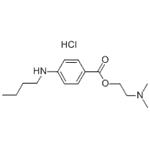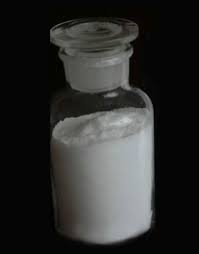Medical uses of Tetracaine hydrochloride
Oct 8,2019
Tetracaine hydrochloride, also known as amethocaine hydrochloride, is a local anesthetic used to numb the eyes, nose, or throat.It may also be used before starting an intravenous to decrease pain from the procedure.Typically it is applied as a liquid to the area.
Tetracaine hydrochloride was patented in 1930 and came into medical use in 1941.It is on the World Health Organization's List of Essential Medicines, the most effective and safe medicines needed in a health system.The wholesale cost in the developing world is about US$1.34–1.63 per 10 ml bottle.In the United Kingdom the eye drops cost the NHS about 0.49 pounds per dose.

Medical uses
A systematic review investigated Tetracaine hydrochloride for use in emergency departments, especially for starting intravenous lines in children, in view of its analgesic and cost-saving properties. However, it did not find an improvement in first-attempt cannulations.
Tetracaine hydrochloride is the T in TAC, a mixture of 5 to 12% Tetracaine hydrochloride, 0.05% adrenaline, and 4 or 10% cocaine hydrochloride used in ear, nose, and throat surgery and in the emergency department where numbing of the surface is needed rapidly, especially when children have been injured in the eye, ear, or other sensitive locations.
Mechanism
In biomedical research, Tetracaine hydrochloride is used to alter the function of calcium release channels (ryanodine receptors) that control the release of calcium from intracellular stores. Tetracaine hydrochloride is an allosteric blocker of channel function. At low concentrations, Tetracaine hydrochloride causes an initial inhibition of spontaneous calcium release events, while at high concentrations, Tetracaine hydrochloride blocks release completely.
Side Effects
Get emergency medical help if signs of an allergic reaction hives; difficult breathing; swelling of your face, lips, tongue, or throat.
A light-headed feeling
Tremors, severe drowsiness
Weak or shallow breathing
Severe headache, neck stiffness, increased sensitivity to light
Numbness, tingling, burning pain, or severe shooting pains anywhere in your body.
- Related articles
- Related Qustion
- Tetracaine Hydrochloride: A Comprehensive Overview Oct 25, 2024
Tetracaine Hydrochloride (TTC) is a long-acting local anesthetic commonly used for topical anesthesia.
- Tetracaine hydrochloride: mechanism of action and activity Jun 21, 2023
Tetracaine hydrochloride is a versatile compound that exhibits multiple pharmacological activities, including potent antitumor effects, antibacterial properties, and long-acting local anesthetic.
- What is Tetracaine Hydrochloride used for? Sep 28, 2020
Tetracaine hydrochloride is also known as ropivacaine hydrochloride, pantocaine, pantocaine and four ropivacaine hydrochloride. It is easily soluble in water and ethanol, but insoluble in ether, benzene.
Hair removal products, also called depilatories, are creams and gels which dissolve the protein structure (keratin) of hair so it separates from the skin. Calcium thioglycolate is an active ingredient in some hair removal products, includin....
Oct 8,2019Organic ChemistryGold extraction strongly depends on the nature of the ore and type of deposits. There are two main methods of gold recovery: the placer or gravity separation method and the cyaniding process.....
Oct 8,2019Inorganic chemistryTetracaine hydrochloride
136-47-0You may like
Tetracaine hydrochloride manufacturers
- Tetracaine hydrochloride
-

- $0.00 / 1G
- 2025-05-08
- CAS:136-47-0
- Min. Order: 1G
- Purity: 99%
- Supply Ability: 1 ton/year
- Tetracaine hydrochloride
-

- 2025-05-08
- CAS:136-47-0
- Min. Order:
- Purity: 0.99
- Supply Ability:
- Tetracaine hydrochloride
-

- $0.00 / 1kg
- 2025-05-08
- CAS:136-47-0
- Min. Order: 1kg
- Purity: 98
- Supply Ability: 1000






